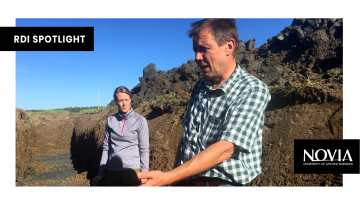PRECIKEM: For the wellbeing of our waters
Did you know that fish death in rivers and streams is a recurring problem during spring and autumn? A new method to combat this and protect our ecosystems has been developed by researchers at Novia University of Applied Sciences, with the help of several different partners.
Let’s rewind to 2008, when Sten Engblom, research manager at Novia University of Applied Sciences, initiated a collaboration with a colleague at Vaasa University of Applied Sciences (VAMK). Sten had previously worked at the Centre for the Environment and noticed a recurring problem: every spring and autumn, when water ran off from fields, fish and other organisms died in rivers and streams.
It turns out that this is due to the pH level dropping in the waters and the metal concentrations increasing. The goal of the project, which was named PRECIKEM, became to reduce the mortality of fish and other organisms by reducing harmful substances that are carried out into the water from agricultural areas.
When an area, usually agricultural land but also construction sites, is drained, cracks form in the clay. These cracks cause sulfur in the soil to react with oxygen and sulfuric acid is formed. The acid leaches metals from soil minerals and these are then carried into the water of rivers and streams when melting snow and rainwater flow through the cracks in spring and autumn.
How can this be prevented?
The method developed in the project involves hindering the pH level from dropping in the water. Researchers Sten Engblom and Eva Högfors-Rönnholm argue that it is best to prevent the problem before it arises. The PRECIKEM method consists of adding a lime suspension into the clay cracks in the drained area. The lime suspension neutralizes the formed acid and precipitates metals in solution. The higher pH value creates additionally an unfavorable environment for microbes that speed up the reaction. Furthermore, the lime suspension is forming a protective layer on the crack surfaces to prevent the reaction altogether. This way, the reaction is stopped before it’s even begun.
Sten Engblom emphasizes that the project has been characterized by collaboration from the very beginning, which has enabled extensive research. The project includes both basic and applied research, and the resulting method is a new innovation. An important partner has been YA – Vocational College of Ostrobothnia (Yrkesakademin i Österbotten), whose agricultural land has made the practical implementation of the PRECIKEM project possible. Åbo Akademi University has contributed with geological knowledge and the Linnaeus University in Kalmar with microbiological expertise. The strengths and competencies of the various partners have contributed to a multifaceted approach in the project.
So, what is the next step for PRECIKEM?
The project has gained traction in the industry through journals, conferences, and via control boards and associations. Sten Engblom and Eva Högfors-Rönnholm continue to work on the theme and their ongoing work will focus on deepening the research further, with the hope of having a significant impact on the industry. With support from new and existing partners, the work to create healthy rivers and streams continues!
Our RDI Spotlight highlights the lasting impact of Novia University of Applied Sciences' research, development, and innovation (RDI) efforts on the world around us.
